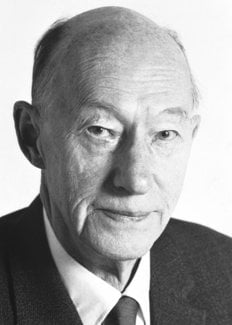Eyvind Johnson
Biographical

Born in 1900 at Svartbjörnsbyn near Boden in the north of Sweden.
Parents, Olof Petter J., stonecutter from Värmland, and Cevia Gustafsdotter from Blekinge. There were six children in the family, of whom E.J. was the next youngest. His father fell ill with silicosis about 1904, and E.J. was taken care of by his childless aunt and her husband, stonecutter Anders Johan Rost. At the age of fourteen he left his foster-parents, of whom he was very fond, to look for work near the home where he was born.
He did many different kinds of work, first at the timber sorting town near Sävast on the Lule River, then at the Björn brickworks. Between 1915 and 1919 he was a sawmill worker, a ticket seller and usher at a cinema, and a projectionist; then assistant to plumbers and electricians. In 1918 he was a locomotive cleaner at the engine sheds in Boden, and for a time during the winter, a stoker on cargo trains between Boden and Haparanda. Again, sawmill worker for a while, then hay-presser, then out of work. Borrowing money, he travelled down to Stockholm, where he got work at LM Ericsson’s big workshop in Tulegatan. The metalworkers’ strike broke out in 1920 and he tried to live on what he wrote, with very meagre results. At the same time, together with some other young budding writers, he founded the literary magazine Vår Nutid (Our Present Day), which appeared in six issues. He then became a member the society of future writers which called itself De gröna (The Green Ones).
From the autumn of 1920 to the autumn of 1921, together with two or three friends, he worked at haymaking and timber-felling on a small farm in Uppland, where he had spare time and peace in which to read and write.
In the autumn of 1921 he went to Germany – by cargo boat to Kiel, by train to Berlin, and a few months later he continued via the Rhineland to Paris, where he earned his living writing for Swedish papers, as a cement worker, and then as a dishwasher at a big hotel near the Gare du Nord. Then back to Berlin, where he remained until the autumn of 1923, when he returned home to Sweden.
His first book, De fyra främlingarna (The Four Strangers), a collection of short stories, was finished in the spring of 1924 and published during the autumn. During a winter visit to the North, he finished his second book, which was published in the autumn of 1925. By then E.J. was back in France, where he was to live for over five years.
In 1927 he was married at Saint-Leu-La Fôret to Aase Christofersen. Their son Tore was born there in 1928. In 1930 the family moved home to Sweden.
After Aase Johnson’s death, E.J. married Cilla Frankenhaeuser. They have two children, Maria, born 1944, and Anders, born 1946. From 1947 to 1950, E.J. and his family lived in Switzerland and England, and after that at Saltsjöbaden.
| Bibliography |
| De fyra främlingarna (The Four Strangers), 1924 |
| Timans och rättfärdigheten (Timans and Righteousness), 1925 |
| Stad i mörker (Town in Darkness), 1927 |
| Stad i Ljus (Town in Light), 1928; French translation: Lettre recommandée, 1927 |
| Minnas (Remembering), 1928 |
| Kommentar till ett stjärnfall (Commentary on a Falling Star), 1929 |
| Avsked till Hamlet (Farewell to Hamlet), 1930 |
| Natten är här (Night is here), 1932 |
| Bobinack, 1932 |
| Regn i gryningen (Rain at Dawn), 1933 |
| Romanen om Olof (The Novel of Olof): 1. Nu var det 1914 (The Year was 1914), 1934; 2. Här har du ditt liv! (Here is Your Life! ),1935; 3. Se dig inte om! (Don’t Look Back!), 1936; 4. Slutspel i ungdomen (Postlude to Youth), 1937 |
| Nattövning (Night Manoeuvre), 1938 |
| Den trygga världen (The Safe World), 1940 |
| Soldatens återkomst (The Return of the Soldier), 1940 |
| Krilonromanen (The Novel of Krilon): 1. Grupp Krilon (Group Krilon), 1941; 2. Krilons resa (Krilon’s Journey), 1942; 3. Krilon själv (Krilon Himself), 1943 |
| Strändernas svall (English translation: Return to Ithaca ): novel, 1946; stage version, 1948 |
| Dagbok från Schweiz (Swiss Diary), 1949 |
| Drömmar om rosor och eld (Dreams of Roses and Fire), 1949 |
| Lägg undan solen (Put Away the Sun), 1951 |
| Romantisk berättelse (A Romantic Story), 1953 |
| Tidens gång (The Course of Time), 1955 |
| Vinterresa i Norrbotten (A Winter Journey in Norrbotten), 1955 |
| Molnen över Metapontion (The Clouds Over Metapontion), 1957 |
| Vägar över Metaponto – en resedagbok (Roads by Metaponto – A Travel Diary), 1959 |
| Hans Nådes tid (English translation: The Days of His Grace), 1960 |
| Spår förbi Kolonos – en berättelse (Traces Past Colonus – A Story), 1961 |
| Livsdagen lång (Life’s Long Day), 1964 |
| Stunder, vågor – anteckningar, berättelser (Moments, Waves – Notes, Stories), 1965 |
| Favel ensam (Favel Alone), 1968 |
| Resa i hösten 1921 (Journey in the Autumn of 1921), 1973 |
| Några steg mot tystnaden (Some Steps Towards Silence), 1973 |
Eyvind Johnson died in 1976.
This autobiography/biography was written at the time of the award and first published in the book series Les Prix Nobel. It was later edited and republished in Nobel Lectures. To cite this document, always state the source as shown above.
Eyvind Johnson died on August 25, 1976.
Nobel Prizes and laureates
Six prizes were awarded for achievements that have conferred the greatest benefit to humankind. The 12 laureates' work and discoveries range from proteins' structures and machine learning to fighting for a world free of nuclear weapons.
See them all presented here.
